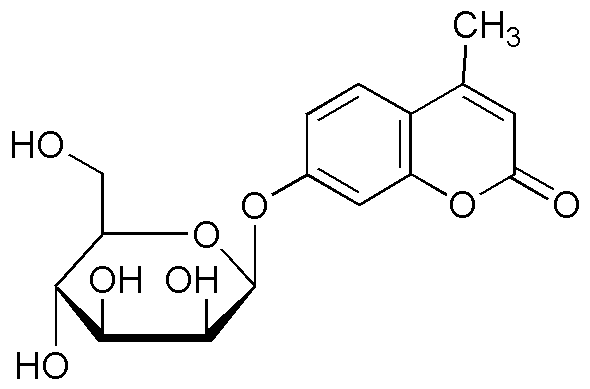4-Methylumbelliferyl-b-D-mannopyranoside is widely utilized in research focused on:
- Enzyme Activity Assays: This compound serves as a substrate for various glycosidases, enabling researchers to measure enzyme activity in biochemical assays effectively.
- Fluorescent Labeling: It is used in fluorescence microscopy to visualize cellular processes, providing a clear method to track enzyme interactions in live cells.
- Carbohydrate Research: This chemical aids in the study of carbohydrate metabolism and glycosylation processes, which are crucial for understanding cellular functions and disease mechanisms.
- Diagnostics Development: It plays a role in developing diagnostic tests for certain diseases by helping to identify specific enzyme activities related to pathological conditions.
- Biotechnology Applications: The compound is valuable in various biotechnological processes, including the production of biofuels and biopolymers, due to its role in carbohydrate breakdown.
General Information
Properties
Safety and Regulations
Applications
4-Methylumbelliferyl-b-D-mannopyranoside is widely utilized in research focused on:
- Enzyme Activity Assays: This compound serves as a substrate for various glycosidases, enabling researchers to measure enzyme activity in biochemical assays effectively.
- Fluorescent Labeling: It is used in fluorescence microscopy to visualize cellular processes, providing a clear method to track enzyme interactions in live cells.
- Carbohydrate Research: This chemical aids in the study of carbohydrate metabolism and glycosylation processes, which are crucial for understanding cellular functions and disease mechanisms.
- Diagnostics Development: It plays a role in developing diagnostic tests for certain diseases by helping to identify specific enzyme activities related to pathological conditions.
- Biotechnology Applications: The compound is valuable in various biotechnological processes, including the production of biofuels and biopolymers, due to its role in carbohydrate breakdown.
Documents
Safety Data Sheets (SDS)
The SDS provides comprehensive safety information on handling, storage, and disposal of the product.
Product Specification (PS)
The PS provides a comprehensive breakdown of the product’s properties, including chemical composition, physical state, purity, and storage requirements. It also details acceptable quality ranges and the product's intended applications.
Certificates of Analysis (COA)
Search for Certificates of Analysis (COA) by entering the products Lot Number. Lot and Batch Numbers can be found on a product’s label following the words ‘Lot’ or ‘Batch’.
*Catalog Number
*Lot Number
Certificates Of Origin (COO)
This COO confirms the country where the product was manufactured, and also details the materials and components used in it and whether it is derived from natural, synthetic, or other specific sources. This certificate may be required for customs, trade, and regulatory compliance.
*Catalog Number
*Lot Number
Safety Data Sheets (SDS)
The SDS provides comprehensive safety information on handling, storage, and disposal of the product.
DownloadProduct Specification (PS)
The PS provides a comprehensive breakdown of the product’s properties, including chemical composition, physical state, purity, and storage requirements. It also details acceptable quality ranges and the product's intended applications.
DownloadCertificates of Analysis (COA)
Search for Certificates of Analysis (COA) by entering the products Lot Number. Lot and Batch Numbers can be found on a product’s label following the words ‘Lot’ or ‘Batch’.
*Catalog Number
*Lot Number
Certificates Of Origin (COO)
This COO confirms the country where the product was manufactured, and also details the materials and components used in it and whether it is derived from natural, synthetic, or other specific sources. This certificate may be required for customs, trade, and regulatory compliance.


